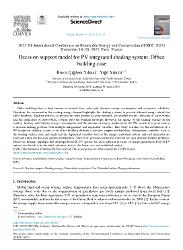| dc.contributor.author | Yılmaz, B.Ç. | |
| dc.contributor.author | Yılmaz, Y. | |
| dc.date.accessioned | 2023-10-19T15:05:24Z | |
| dc.date.available | 2023-10-19T15:05:24Z | |
| dc.date.issued | 2023 | |
| dc.identifier.issn | 2352-4847 | |
| dc.identifier.uri | https://doi.org/10.1016/j.egyr.2023.08.083 | |
| dc.identifier.uri | https://hdl.handle.net/20.500.12469/4871 | |
| dc.description.abstract | Office buildings have a high amount of internal heat, solar gain, daytime energy consumption and occupancy schedules. Therefore, the increment in the cooling energy demand highlights the shading systems to provide efficient energy retrofit for office buildings. Shading surfaces, to prevent the high amount of solar radiation, are suitable for the collection of solar energy and the integration of photovoltaic systems onto the building envelope. However, the impact of the shading surface on the cooling, heating, and lighting energy consumption and the amount of energy produced by the PV system is a great task as a decision-making problem with multiple independent and dependent variables. This study searches for the installation of a PV integrated shading system to an office building through a decision support methodology. Independent variables such as the shading surface area, and angle and the dependent variables such as the energy, embodied carbon, and cost indicators are analysed within the decision support methodology. The results provide a definitive structure for such decision-making problems. Moreover, findings highlight that although Mono-Si PV options are more efficient in terms of energy generation, Poly-Si PV options are found to be the ideal solutions, due to the lower cost and embodied carbon. © 2023 The Author(s) | en_US |
| dc.description.sponsorship | The author(s) declare no potential conflict of interest and the authors received no financial support with respect to the research and authorship of this paper. | en_US |
| dc.language.iso | eng | en_US |
| dc.publisher | Elsevier Ltd | en_US |
| dc.relation.ispartof | Energy Reports | en_US |
| dc.rights | info:eu-repo/semantics/openAccess | en_US |
| dc.subject | Cost | en_US |
| dc.subject | Decision-support | en_US |
| dc.subject | Embodied carbon | en_US |
| dc.subject | Energy performance | en_US |
| dc.subject | Photovoltaic integration | en_US |
| dc.subject | Shading strategy | en_US |
| dc.subject | Carbon | en_US |
| dc.subject | Cooling systems | en_US |
| dc.subject | Decision making | en_US |
| dc.subject | Decision support systems | en_US |
| dc.subject | Energy efficiency | en_US |
| dc.subject | Office buildings | en_US |
| dc.subject | Silicon compounds | en_US |
| dc.subject | Solar energy | en_US |
| dc.subject | Solar power generation | en_US |
| dc.subject | Decision supports | en_US |
| dc.subject | Decision-making problem | en_US |
| dc.subject | Embodied carbons | en_US |
| dc.subject | Energy | en_US |
| dc.subject | Energy performance | en_US |
| dc.subject | Energy-consumption | en_US |
| dc.subject | Photovoltaic integration | en_US |
| dc.subject | Photovoltaics | en_US |
| dc.subject | Shading strategy | en_US |
| dc.subject | Shading systems | en_US |
| dc.subject | Energy utilization | en_US |
| dc.title | Decision support model for PV integrated shading system: Office building case | en_US |
| dc.type | article | en_US |
| dc.identifier.startpage | 112 | en_US |
| dc.identifier.endpage | 117 | en_US |
| dc.identifier.volume | 9 | en_US |
| dc.department | N/A | en_US |
| dc.identifier.doi | 10.1016/j.egyr.2023.08.083 | en_US |
| dc.identifier.scopus | 2-s2.0-85170405346 | en_US |
| dc.institutionauthor | N/A | |
| dc.relation.publicationcategory | Makale - Uluslararası Hakemli Dergi - Kurum Öğretim Elemanı | en_US |
| dc.authorscopusid | 57210918537 | |
| dc.authorscopusid | 57201068793 | |
| dc.khas | 20231019-Scopus | en_US |
















